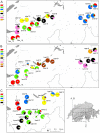Patterns of genetic variation across altitude in three plant species of semi-dry grasslands
- PMID: 22870236
- PMCID: PMC3411590
- DOI: 10.1371/journal.pone.0041608
Patterns of genetic variation across altitude in three plant species of semi-dry grasslands
Abstract
Background: Environmental gradients caused by altitudinal gradients may affect genetic variation within and among plant populations and inbreeding within populations. Populations in the upper range periphery of a species may be important source populations for range shifts to higher altitude in response to climate change. In this study we investigate patterns of population genetic variation at upper peripheral and lower more central altitudes in three common plant species of semi-dry grasslands in montane landscapes.
Methodology/principal findings: In Briza media, Trifolium montanum and Ranunculus bulbosus genetic diversity, inbreeding and genetic relatedness of individuals within populations and genetic differentiation among populations was characterized using AFLP markers. Populations were sampled in the Swiss Alps at 1800 (upper periphery of the study organisms) and at 1200 m a.s.l. Genetic diversity was not affected by altitude and only in B. media inbreeding was greater at higher altitudes. Genetic differentiation was slightly greater among populations at higher altitudes in B. media and individuals within populations were more related to each other compared to individuals in lower altitude populations. A similar but less strong pattern of differentiation and relatedness was observed in T. montanum, while in R. bulbosus there was no effect of altitude. Estimations of population size and isolation of populations were similar, both at higher and lower altitudes.
Conclusions/significance: Our results suggest that altitude does not affect genetic diversity in the grassland species under study. Genetic differentiation of populations increased only slightly at higher elevation, probably due to extensive (historic) gene flow among altitudes. Potentially pre-adapted genes might therefore spread easily across altitudes. Our study indicates that populations at the upper periphery are not genetically depauperate or isolated and thus may be important source populations for migration under climate change.
Conflict of interest statement
Figures



References
-
- Körner C (2007) The use of ‘altitude’ in ecological research. Trends in Ecology & Evolution 22: 569–574. - PubMed
-
- Ohsawa T, Ide Y (2008) Global patterns of genetic variation in plant species along vertical and horizontal gradients on mountains. Global Ecology and Biogeography 17: 152–163.
-
- Thomas CD, Cameron A, Green RE, Bakkenes M, Beaumont LJ, et al. (2004) Extinction risk from climate change. Nature 427: 145–148. - PubMed
-
- Sala OE, Chapin FS, Armesto JJ, Berlow E, Bloomfield J, et al. (2000) Global biodiversity scenarios for the year 2100. Science 287: 1770–1774. - PubMed
-
- Grabherr G, Gottfried M, Pauli H (1994) Climate effects on mountain plants. Nature 369: 448–448. - PubMed
Publication types
MeSH terms
LinkOut - more resources
Full Text Sources

